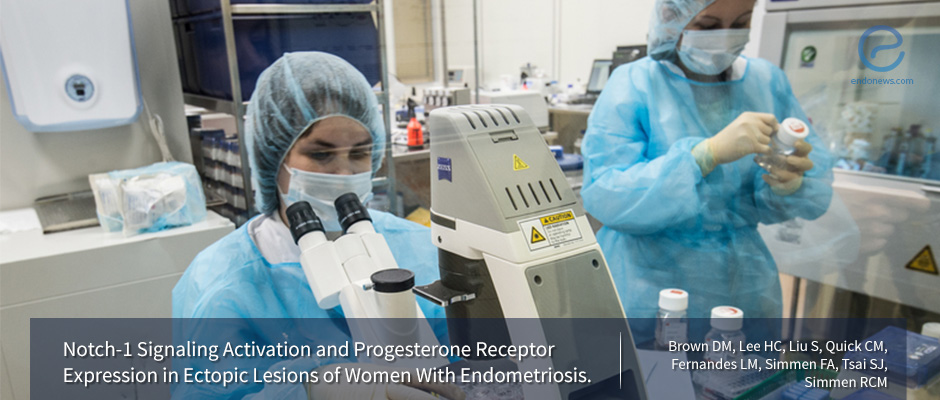Additional research in understanding the causative link between Notch signaling and endometriosis
Feb 18, 2019
Aberrant Notch-1 activation may underlie the progestin resistance in endometriosis.
Key Points
Highlights:
- Aberrant Notch-1 activation is associated with decreased PGR suggesting that it contributes to P resistance in endometriosis.
Importance:
- Since blockage of Notch-1 activation may help management of endometriosis, studies to understand the causative link between Notch signaling and endometriosis are warranted.
What's done here:
- Archived tissue samples of eutopic endometria and endometriosis samples collected from surgically treated patients were analyzed for Notch Intra-Cellular Domain 1 (NICD1) and Progesterone receptor expression; and also for transcript levels of the target genes of NICD1 (namely HES1, PGR, and PGR-B)
- On the other hand, human endometrial stromal cell lines were treated with Notch-1 suppressor (DAPT) and activator (Valproic acid-VPA), respectively; and evaluated for cell numbers and for PGR, HES1, and DKK1 (PGR target gene) transcript levels, for the groups with and without Progesterone cotreatment.
Key Results:
- Stromal cells of endometriotic lesions displayed higher HES1 and lower total PGR and PGR-B transcript levels than eutopic ones. Aberrant Notch-1 activation seems to be associated with decreased Progesterone receptor that contributes to Progesterone resistance in endometriosis.
- Relative to eutopic cells, endometriosis stromal cells showed higher percentages of NICD1 along with higher percentages of the proliferation marker (Ki67) and estrogen receptor-b (ESR2), BUT lower Progesterone receptor.
- However, the percentage of nuclear estrogen receptor-a (ESR1)–expressing cells was comparable between eutopic endometrium and endometriosis.
- When paired eutopic endometrium and endometriosis were evaluated for an association between NICD1 activation and PGR expression, it was found that stromal HES1 transcript levels were higher for endometriosis, whereas those for JAG2 did not differ.
- Notch-1 inhibitor (DAPT) decreased and activator (VPA) increased the percentage of cells with nuclear-localized Progesterone receptor.
Lay Summary
Dustin M. Brown and associates from the University of Arkansas for Medical Sciences published their unique complex molecular research in the Journal of the Endocrine Society. This study group previously showed that decreased expression of the progesterone receptor (PGR) resulted from aberrant activation of Notch-1 signaling in mouse uteri. Since the blockage of Notch-1 activation may help clinical management of endometriosis, studies to understand the causative link between Notch signaling and endometriosis are valuable.
Eutopic endometria and endometriotic lesions of surgically diagnosed patients and archived tissue sections were analyzed for Notch Intra-Cellular Domain 1 (NICD1) and PGR protein expression immunohistochemically and for transcript levels of NICD1 target genes HES1, PGR, and PGR-B. Human endometrial stromal cell lines were treated with Notch-1 inhibitor (DAPT) and activator (valproic acid -VPA), respectively, to suppress and induce Notch-1 activation. DAPT- or VPA-treated HESCs with and without P cotreatment were evaluated for cell numbers and for PGR, HES1, and PGR target gene DKK1 transcript levels.
The results demonstrated induction of Notch-1 signaling, assessed by the higher levels of nuclear-localized NICD1 and of HES1 transcript, in stromal cells of endometriosis relative to eutopic endometrium. In addition to a negative association between Notch-1 activation and PGR expression, increased proliferation and enhanced ESR2 expression were detected indometriotic cells, relative to ectopic endometrium. Finally, in an endometrial stromal cell line (HESC), by using pharmacological modifiers of Notch-1 signaling, P sensitivity is optimally sustained with reduction of Notch-1 activation (by DAPT) and, conversely, is robustly attenuated with continued Notch-1 activation (by VPA), due in part to negative regulation by activated Notch of PGR expression.
These results support a role for chronic Notch-1 signaling activation underlying Progesterone resistance in women with endometriosis and suggest that the clinical management of the disease may benefit from stringent control of Notch-1 signaling in endometrial stromal cells. In conclusion, these findings indicate that aberrant Notch-1 activation may underlie the progestin resistance of ectopic lesions of women with endometriosis. Studies with larger patient populations are indicated to support this functional link.
Research Source: https://www.ncbi.nlm.nih.gov/pubmed/30151432
Notch-1 etiopathogenesis of endometriosis molecular aberrations in endometriosis

